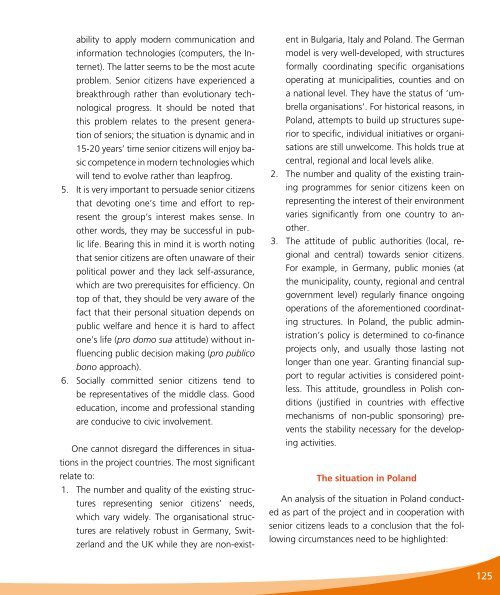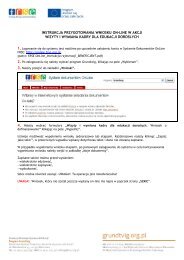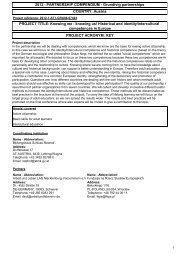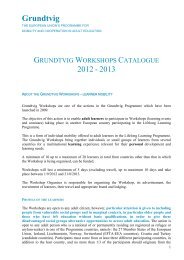Pobierz plik - Grundtvig
Pobierz plik - Grundtvig
Pobierz plik - Grundtvig
You also want an ePaper? Increase the reach of your titles
YUMPU automatically turns print PDFs into web optimized ePapers that Google loves.
ability to apply modern communication and<br />
information technologies (computers, the Internet).<br />
The latter seems to be the most acute<br />
problem. Senior citizens have experienced a<br />
breakthrough rather than evolutionary technological<br />
progress. It should be noted that<br />
this problem relates to the present generation<br />
of seniors; the situation is dynamic and in<br />
15-20 years’ time senior citizens will enjoy basic<br />
competence in modern technologies which<br />
will tend to evolve rather than leapfrog.<br />
5. It is very important to persuade senior citizens<br />
that devoting one’s time and effort to represent<br />
the group’s interest makes sense. In<br />
other words, they may be successful in public<br />
life. Bearing this in mind it is worth noting<br />
that senior citizens are often unaware of their<br />
political power and they lack self-assurance,<br />
which are two prerequisites for efficiency. On<br />
top of that, they should be very aware of the<br />
fact that their personal situation depends on<br />
public welfare and hence it is hard to affect<br />
one’s life (pro domo sua attitude) without influencing<br />
public decision making (pro publico<br />
bono approach).<br />
6. Socially committed senior citizens tend to<br />
be representatives of the middle class. Good<br />
education, income and professional standing<br />
are conducive to civic involvement.<br />
One cannot disregard the differences in situations<br />
in the project countries. The most significant<br />
relate to:<br />
1. The number and quality of the existing structures<br />
representing senior citizens’ needs,<br />
which vary widely. The organisational structures<br />
are relatively robust in Germany, Switzerland<br />
and the UK while they are non-existent<br />
in Bulgaria, Italy and Poland. The German<br />
model is very well-developed, with structures<br />
formally coordinating specific organisations<br />
operating at municipalities, counties and on<br />
a national level. They have the status of ‘umbrella<br />
organisations’. For historical reasons, in<br />
Poland, attempts to build up structures superior<br />
to specific, individual initiatives or organisations<br />
are still unwelcome. This holds true at<br />
central, regional and local levels alike.<br />
2. The number and quality of the existing training<br />
programmes for senior citizens keen on<br />
representing the interest of their environment<br />
varies significantly from one country to another.<br />
3. The attitude of public authorities (local, regional<br />
and central) towards senior citizens.<br />
For example, in Germany, public monies (at<br />
the municipality, county, regional and central<br />
government level) regularly finance ongoing<br />
operations of the aforementioned coordinating<br />
structures. In Poland, the public administration’s<br />
policy is determined to co-finance<br />
projects only, and usually those lasting not<br />
longer than one year. Granting financial support<br />
to regular activities is considered pointless.<br />
This attitude, groundless in Polish conditions<br />
(justified in countries with effective<br />
mechanisms of non-public sponsoring) prevents<br />
the stability necessary for the developing<br />
activities.<br />
The situation in Poland<br />
An analysis of the situation in Poland conducted<br />
as part of the project and in cooperation with<br />
senior citizens leads to a conclusion that the following<br />
circumstances need to be highlighted:<br />
125







